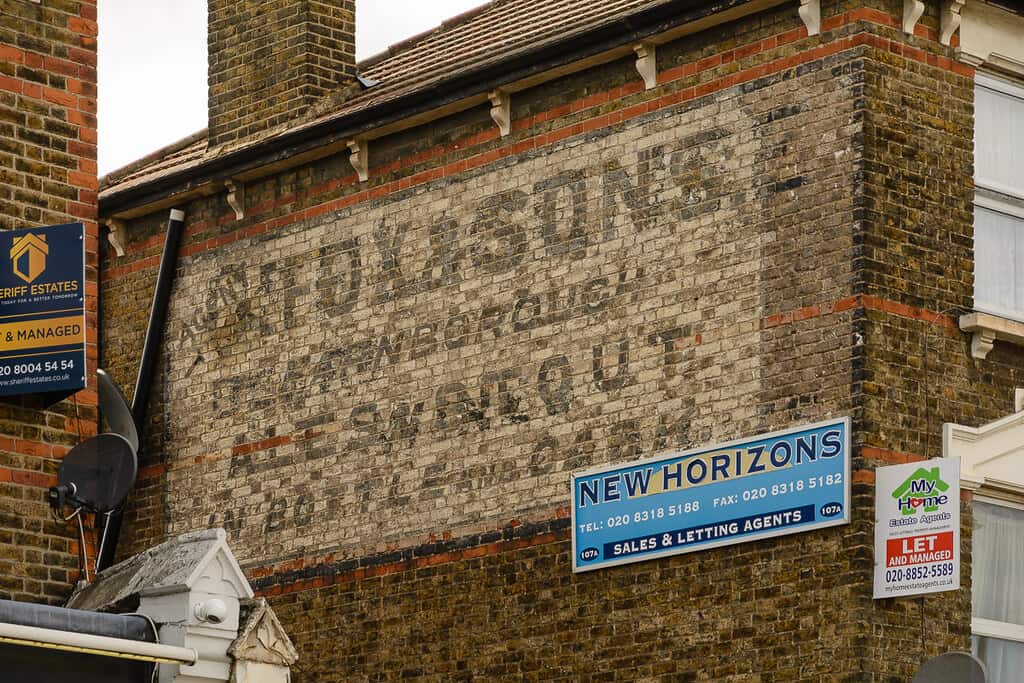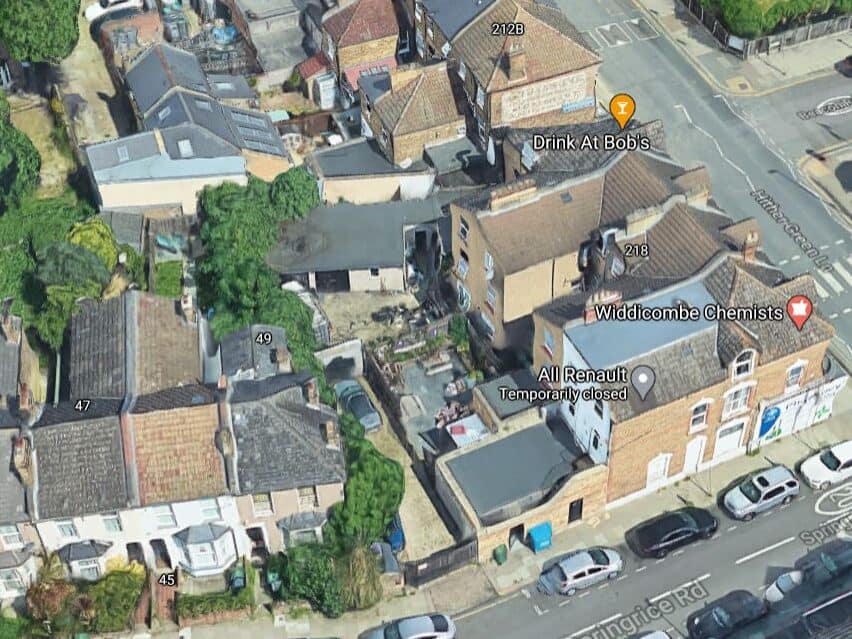22 Mar 2021
A Sly Fox (& Sons) on Hither Green Lane

This post was drafted just before the puzzle was brilliantly solved by the Lewisham Local History and Archives Centre. Nevertheless, I thought it would still be interesting to share as an example of formulating and testing hypotheses, the danger of assumptions, and that often the simplest answer is the right one.
A Fox & Sons Privilege
The sign advertised the Fox & Sons brewery and reads as follows:
Agent for / Fox & Sons / Farnborough / Ales & Stout / In Bottle and Cask
The important phrase here is ‘agent for’ which precedes the Fox & Sons name. This meant that we were looking for retail premises that would sell beer, rather than the brewery itself, which was located in Farnborough. A pub or off license would be the obvious candidates, with the sign then serving as a ‘privilege’ on their building.
Hither Green Lane Businesses
The building that hosts the sign is now 212 Hither Green Lane, London SE13. This is on the West side of the street, opposite Beacon Road, and between Theodore Road to the North and Springrice Road to the South. The building appears to have been bulit at the turn of the 19th and 20th Centuries and early work using street directories had it occupied by grocers from 1904. Then, in 1920, the John Lovibond & Sons bottle shop moved in, remaining until at least 1940.
This appeared to be case solved, as we had exactly the type of shop we were looking for and, at that stage, I was assuming that a grocery shop wouldn’t sell beer. (Assume makes an ‘ass’ out of ‘u’ and ‘me,’ as we’ll see later.)
The Fox & Sons Brewery
The problem with this apparently neat solution was that 1920 is some time after the known dates of operation for the Fox & Sons brewery itself. A detailed history of the business can be found here on the Farnborough Village History website, but the crucial date is 1909. This is when, following years of financial trouble, the business was sold. The pubs went to Truman’s and the goodwill and trade business to Golding & Co.
One line of enquiry at this stage was trying to establish what happened to the Fox & Sons brand after 1909. If it could be shown that the brand was continued by Golding & Co. until at least 1920, then the fit with John Lovibond & Sons would be strengthened.
Via Nick Reynolds at Farnborough Village History, Mike Kempton shared pages from The Brewery History Society Journal (No. 54 of November 1988). These showed that the brand was continued in some form by Golding & Co., but from their brewery in Sevenoaks, rather than Farnborough as shown on the sign. Golding & Co. then also fell into financial difficulty in 1912 and were acquired by London’s Hoare & Co., with the brewery in Sevenoaks closing.
This closed off the John Lovibond & Sons bottle shop hypothesis, and left two possible explanations. The first was that the Fox & Sons privilege was in fact for a grocers, and the second came about when looking more closely at the building in the context of its neighbours.
The Mews Next Door
The building immediately in front of the sign is in-fill, and it looks like there used to be a mews leading behind the terrace and connecting to another entrance on Springrice Road. This can be seen on satellite imagery of the location, and the Springrice Road entrance remains at what looks to be number 51, occupied today by All Renault Ltd.


This was a new, and seemingly warm, lead with some more digging required. An article in The Times in 1894 says that the building next door was destroyed by fire, which would explain the gap between the two terraces. (The Running Past blog cites this in an article about the ghost sign.) However, there wasn’t time to follow that line of enquiry any further because…
Case Solved
On Thursday morning, Sally at the Lewisham Local History and Archives Centre replied to an email enquiry with a full unlocking of the puzzle. At that time, I was revisiting the grocers’ privilege theory. In this context I had started noticing examples of other grocers selling alcohol e.g. early grocery chain pioneers Leverett & Frye. It therefore wasn’t entirely unexpected when this was verified in the context of this sign by this very early 1900s photograph.

The picture shows the sign in situ, and at a time when the Fox & Sons brewery was very much operating in Farnborough. The grocery, provision, wine and spirit merchants in the shop were Walter Howell & Co., and the firm is listed there (7 Newington Terrace as it was then known) in both 1900 and 1902. They were probably the first occupants after the construction of the terrace. Another beer company, Ash & Co. Canterbury Ales, then has a sign over the entrance to the mews next door.

Walter Howell & Co.’s time at this location was short-lived, and a succession of grocers followed them between 1904 and 1920, when John Lovibond & Sons moved in.
The Fire: An Aside
The fire mentioned above in an article in The Times turned out to be a red herring. Again, Sally at the Lewisham Local History and Archives Centre was able to shed more light on the matter. By cross-referencing the businesses cited in the original article she deduced that the fire was in fact further down Hither Green Lane at numbers 130–34. It’s possible the confusion stems from the butcher Joseph Hurdidge who later had premises at numbers 132 and 210 Hither Green Lane.
In Summary
In the end the most straightforward answer was true: the sign was a privilege on a grocers shop. My assumption that it would be a pub or off license, rather than a grocers, led to further investigations, including reaching out to many individuals and local historical organisations. The result has been the uncovering of a far richer picture of this sign’s story, and the holy grail with ghost signs – an archival photo showing the sign as it once was.
I’ve personally learned a lot from this particular piece of research, and would like to thank everyone that took the time to conduct their own investigations, namely: Sylvia Eley; Sally Eaton; Simon Finch; Josie Foster; David Fergusson; Christime Hellicar; Mike Kempton; Lewisham Local History and Archives Centre; North West Kent Family History Society; Belinda O’Grady; Nick Reynolds.
Case solved!


